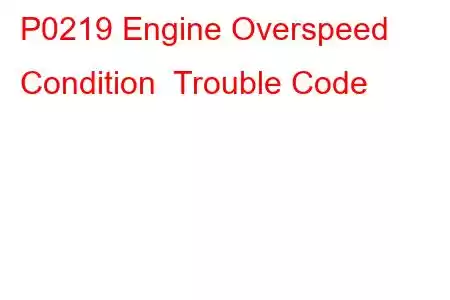P0219 Engine Overspeed Condition
OBD-II Trouble Code Technical Description
Engine Overspeed Condition
What does that mean?
This is a generic powertrain diagnostic trouble code (DTC) and applies to OBD-II vehicles. That may include but is not limited to vehicles from Ford, Honda, Acura, Chevrolet, Mitsubishi, Dodge, Ram, Mercedes-Benz, etc. Although generic, the exact repair steps may vary depending on year, make, model and powertrain configuration.
When a code P0219 is stored, it means that the powertrain control module (PCM) has detected that the engine has been operated at a level of revolutions per minute (RPM) which exceeds the maximum threshold.
The PCM uses input signals from the crankshaft position sensor (CKP), camshaft position sensor (CMP), and the transmission output speed sensor/s to establish whether (or not) an engine overspeed condition has occurred.
In most cases, the overspeed condition will be automatically met with a rev-limiting device when the transmission is in neutral or park. When the PCM detects an overspeed condition, one of several courses of action may be taken. Either the PCM will discontinue fuel injector pulse and/or retard ignition timing to decrease engine RPM until they return to an acceptable level.
If the PCM is unable to effectively return the engine RPM to an acceptable level, within a certain period of time, a code P0219 will be stored and a malfunction indicator lamp (MIL) may be illuminated.
What is the severity of this DTC?
Since over-revving the engine may result in catastrophic damage, a stored code P0219 should be addressed with some degree of urgency.
Instrument cluster showing tachometer in action:
What are some of the symptoms of the code?
Symptoms of a P0219 trouble code may include:
There will likely be no drivability symptoms associated with a stored code P0219 The engine may be allowed to over-rev repeatedly Knock sensor activation/knock sensor codes Clutch slippage (vehicles with manual transmissions)What are some of the common causes of the code?
Causes for this P0219 transmission code may include:
Driver error from deliberate or accidental over revving of the engine Defective CKP or CMP sensor Bad transmission input or output speed sensor Open or shorted circuit in the CKP, CMP, or transmission input/output speed sensor system Faulty PCM or a PCM programming errorWhat are some P0219 troubleshooting steps?
I like to have access to a diagnostic scanner, a digital volt/ohmmeter (DVOM), an oscilloscope, and a reliable vehicle information source before attempting to diagnose a vehicle with a stored code P0219. If available, a scanner with an integrated DVOM and oscilloscope will work well for this task.
Obviously, you want to ensure that the vehicle has not been (deliberately or inadvertently) operated at RPM levels which are greater than those recommended by the manufacturer. This is especially true when considering vehicles with manual transmissions. In these types of vehicles, you will also want to ensure that the clutch is working effectively before attempting to diagnose this code.
You will want to connect the scanner to the diagnostic port of the vehicle and retrieve all stored codes and freeze frame data. Writing this information down has proven helpful (to me) more times than I can count. Now, clear the codes and operate the vehicle normally to see if the code is reset.
If the codes reset:
Use the DVOM and the oscilloscope to test the CKP, CMP, and transmission speed sensors as recommended in the vehicle information source. Replace sensors as require Test reference voltage and ground circuits at sensor connectors using the DVOM. The vehicle information source should yield valuable information regarding appropriate voltage on individual circuits Disconnect all related controllers and test individual system circuits (resistance and continuity) with the DVOM. Repair or replace system circuits as needed If all related sensors, circuits, and connectors are within manufacturer’s specifications (as they appear in the vehicle information source), suspect a defective PCM or a PCM programing error Check related Technical Service Bulletins (TSB) as a secondary source of diagnostic help Make sure that all vehicle safety recalls (related to the issue at hand) have been satisfied before proceeding with your diagnosisRead: 46


